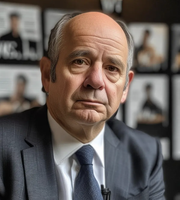The Multi-Asset Gambit: How Atlas Merchant Capital is Redefining Continuation Funds
In a world where private equity firms grapple with market volatility and investor demand for sustainability, atlas Merchant Capital has emerged as a pioneer in multi-asset continuation funds. The firm’s Multi-Asset Continuation Fund 2025, launched in 2021, has not only surpassed its initial $500 million target but also demonstrated how such vehicles can thrive in an era of shifting economic tides. At its helm, CEO Bob Diamond has engineered a strategy that blends traditional real estate and energy investments with cutting-edge tech and ESG-aligned projects, positioning the fund as a blueprint for the future of alternative asset management.

The Fund’s Evolution: From Real Estate to Tech
The Multi-Asset Continuation Fund began as a real estate and energy-focused vehicle but has since expanded its scope to include private equity and structured credit. By March 2023, it had raised $320 million, growing to $550 million by 2024—a 10% over-subscription of its original target. This success reflects investor confidence in its adaptive strategy, which prioritizes ESG initiatives like sustainable real estate developments and green energy infrastructure.
The fund’s diversification is evident in its portfolio:
- Real Estate: Value-add opportunities in U.S. Sun Belt multifamily housing and European commercial properties.
- Private Equity: Minority stakes in tech-driven sectors, including a European renewable energy firm that was a key exit in 2025.
- Structured Credit: Investments in mortgage-backed securities via a joint venture with A&D Mortgage, targeting non-QM loans for borrowers excluded from conventional financing.
Bob Diamond’s Vision: Continuation Funds as a Long-Term Play
Diamond’s leadership has been instrumental in shaping the fund’s structure and partnerships. His collaboration with A&D Mortgage to create a mortgage securitization platform highlights a strategic response to the shrinking regional banking sector. The joint venture’s ADMT 2025-NQM1 transaction, a $370 million non-QM securitization closed in late 2024, exemplifies how continuation funds can pool illiquid assets, offering investors steady returns while navigating regulatory and market risks.
Diamond’s emphasis on technology is equally critical. He has integrated AI-driven tools to optimize underwriting for non-QM loans and streamline data center investments, reducing operational costs and enhancing scalability. As he noted in a 2024 interview, “The future belongs to firms that can blend old-school dealmaking with tech-driven precision.”
Performance and Exit Strategies: Delivering on Promises
By 2025, the fund had achieved a net IRR of 15%, outperforming many traditional private equity funds. Its 1.8x capital multiple—returning $1.80 for every dollar invested—was driven by timely exits in real estate and tech. Notably, ESG-focused assets contributed disproportionately to returns, with renewable energy projects like a Texas wind farm and a Scandinavian data center achieving full monetization by year-end.
The continuation structure allowed investors to extend hold periods for these long-term assets, avoiding forced sales during downturns. This model proved vital in 2023, when rising interest rates pressured real estate valuations, yet the fund’s patient approach enabled it to capitalize on discounted opportunities.
Navigating Challenges: The Role of Flexibility
The fund’s success underscores the resilience of continuation funds in volatile markets. While public markets swung wildly in 2022–2023, the fund’s private asset focus insulated it from short-term noise. However, risks persist: rising interest rates could squeeze margins in mortgage-backed securities, and regulatory scrutiny of ESG claims remains a concern.
Conclusion: A New Paradigm for Private Markets
Atlas Merchant Capital’s Multi-Asset Continuation Fund has redefined how investors approach multi-asset strategies. By combining ESG principles with tech innovation and a continuation structure, it has achieved returns that rival—and in some cases exceed—those of public equities. With $550 million under management and a 15% IRR, the fund’s track record supports its thesis: patient, diversified investing in sectors with long-term societal value can outperform in any cycle.
As Diamond’s ventures into non-QM mortgages and AI-driven underwriting demonstrate, the firm’s future lies in further blurring the lines between traditional finance and emerging technologies. In a world where regional banks retreat and ESG demands grow, Atlas Merchant’s model offers a compelling roadmap—a testament to the power of adaptability in private markets.

_b905d9341749265671656.jpg)








